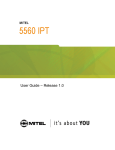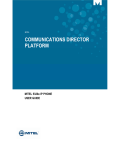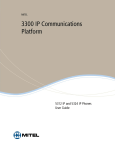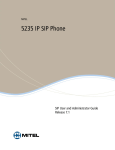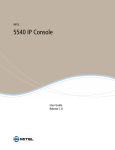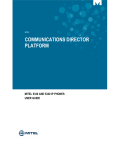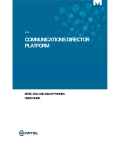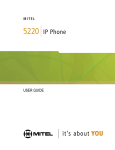Download Mitel 5320 IP Phone User Manual
Transcript
jfqbi=
=
`çããìåáÅ~íáçåë=aáêÉÅíçê=
=
=
RPOM=fm=mÜçåÉ=
rëÉê=dìáÇÉ=
NOTICE
The information contained in this document is not warranted by Mitel Networks Corporation or any of its
affiliates or subsidiaries ("Mitel") and is subject to change without notice. Mitel assumes no liability for any
errors or omissions. This document may be reproduced, either wholly or in part, solely for distribution to
authorized users of Mitel's products. In reproducing this document, content may be removed or reorder,
provided the meaning is not altered. No other amendment to the document is permitted without written
permission from Mitel.
TRADEMARKS
Mitel and Speak@Ease are trademarks of Mitel Networks Corporation.
Windows and Microsoft are trademarks of Microsoft Corporation.
Other product names mentioned in this document may be trademarks of their respective companies and
are hereby acknowledged.
Mitel 5320 IP Phone - User Guide
October 2009
®,™ Trademark of Mitel Networks Corporation
© Copyright 2009, Mitel Networks Corporation
All rights reserved
IMPORTANT! This telephone is NOT suitable for direct connection to the public-switched
telephone network. Connect the telephone to a Mitel Networks system only.
5320 IP Phone – User Guide
ABOUT YOUR PHONE ............................................................................................. 1
Elements of Your Phone...................................................................................................... 2
Ring/Message Indicators ..................................................................................................... 3
For Users on Resilient 3300 ICP Systems .......................................................................... 3
TIPS FOR YOUR COMFORT AND SAFETY ............................................................ 4
Don't Cradle the Handset!.................................................................................................... 4
Protect your Hearing............................................................................................................ 4
Adjust the Viewing Angle ..................................................................................................... 4
USING YOUR DEFAULT PHONE WINDOW AND KEYS......................................... 5
Getting Started with Your Phone ......................................................................................... 5
5320 IP Phone Default Window and Keys ........................................................................... 6
ABOUT YOUR PHONE APPLICATIONS ................................................................. 7
Using the Settings Application ............................................................................................. 7
Using the Call History Application........................................................................................ 8
View Call Log Details ...................................................................................................................... 8
Review Call Log Icons..................................................................................................................... 9
Delete Logs ..................................................................................................................................... 9
Getting Help....................................................................................................................... 10
Tips for Setting up Your Phone.......................................................................................... 10
CUSTOMIZING YOUR PHONE............................................................................... 11
Using the Dial Pad to Enter Information ............................................................................ 11
Using the On-Screen Keyboard to Enter Information ........................................................ 12
Specify Language .............................................................................................................. 12
Specify Display Contrast.................................................................................................... 13
Specify Audio Feedback Options....................................................................................... 14
Specify Text Size ............................................................................................................... 14
Specify Call Notification Behavior...................................................................................... 15
Adjust the Ringer ............................................................................................................... 15
Enable a Screen Saver...................................................................................................... 16
- iii -
5320 IP Phone – User Guide
Enable PC Connectivity ..................................................................................................... 16
PROGRAMING FEATURES ON YOUR KEYS ................................................................. 17
Tips on Programming Features ......................................................................................... 17
Features available for programming on programmable keys........................................................ 17
Applications available for programming on programmable keys .................................................. 18
Program Feature Keys Using the Settings Application...................................................... 19
Clear Programming from a Key ......................................................................................... 20
MAKING AND ANSWERING CALLS ..................................................................... 21
Phone Book ....................................................................................................................... 21
Answer a Call..................................................................................................................... 22
End a Call .......................................................................................................................... 22
Redial................................................................................................................................. 22
Redial - Saved Number ..................................................................................................... 22
Handsfree Operation ......................................................................................................... 22
Auto-Answer ...................................................................................................................... 23
CALL HANDLING ................................................................................................... 24
Hold ................................................................................................................................... 24
Mute................................................................................................................................... 24
Transfer ............................................................................................................................. 25
Conference ........................................................................................................................ 25
Conference Split ................................................................................................................ 25
Add Held ............................................................................................................................ 25
Swap.................................................................................................................................. 26
Call Forwarding.................................................................................................................. 26
USING QUICK CALL FORWARD ALWAYS................................................................................. 26
PROGRAMMING CALL FORWARDING USING PROFILES....................................................... 27
ACTIVATE CALL FORWARD ....................................................................................................... 28
CANCEL CALL FORWARD .......................................................................................................... 28
USING OTHER FEATURES.................................................................................... 29
Account Codes .................................................................................................................. 29
ACD ................................................................................................................................... 29
- iv -
5320 IP Phone – User Guide
Attendant Call Hold - Remote Retrieve.............................................................................. 30
Callback ............................................................................................................................. 30
Call Forward - Remote (I'm Here)...................................................................................... 30
Call Forward - End Chaining.............................................................................................. 31
Call Forward - Forced ........................................................................................................ 31
Call Forward - Override ..................................................................................................... 31
Call Park ............................................................................................................................ 32
Call Pickup......................................................................................................................... 32
Campon ............................................................................................................................. 33
Direct Paging ..................................................................................................................... 33
Direct Paging - Handsfree Answerback Enabled.......................................................................... 33
Direct Paging - Handsfree Answerback Disabled ......................................................................... 34
Direct Voice Call ................................................................................................................ 35
Do Not Disturb ................................................................................................................... 36
Emergency Calls................................................................................................................ 36
Group Listen ...................................................................................................................... 37
Group Paging / Meet Me Answer....................................................................................... 37
Group Presence................................................................................................................. 38
Handoff - Personal Ring Groups........................................................................................ 39
Headset Operation............................................................................................................. 40
Hot Desking ....................................................................................................................... 41
Hot Desk Remote Logout .................................................................................................. 41
Hot Desk - PIN Change ..................................................................................................... 42
Make Busy ......................................................................................................................... 42
Message Waiting Indicator ................................................................................................ 42
Messaging - Advisory ........................................................................................................ 43
Messaging - Callback ........................................................................................................ 43
Messaging - Cancel Callback ............................................................................................ 44
Messaging - Cancel All Callbacks ..................................................................................... 44
Music ................................................................................................................................. 45
Night Answer ..................................................................................................................... 45
-v-
5320 IP Phone – User Guide
Override (Intrude) .............................................................................................................. 45
Paging................................................................................................................................ 45
Phone Lock........................................................................................................................ 46
User PIN ............................................................................................................................ 47
Record-a-Call..................................................................................................................... 48
Speak@Ease..................................................................................................................... 48
Speed Call ......................................................................................................................... 49
Tag Call ............................................................................................................................. 49
Timed Reminder ................................................................................................................ 50
Trunk Flash........................................................................................................................ 50
- vi -
5320 IP Phone – User Guide
ABOUT YOUR PHONE
The Mitel® 5320 IP Phone is full-feature, dual port, dual mode enterprise-class telephone that
provides voice communication over an IP network. It features a large graphics display
(160 x 320) and self-labeling keys. The 5320 IP Phone offers seven programmable
multi-function keys for one-touch feature access. It provides ten fixed feature keys for
convenient access to features such as Conferencing, Redial, and many customizable user
settings as well as navigational keys to access various screens and application layers. The
5320 also features a Mitel Unified Communicator® (UC) Express application, which is a PCbased desktop programming tool that allows you to easily configure your phone from your
Personal Computer (PC).
The 5320 IP Phone supports Mitel Call Control (MiNet) protocol and session initiated
protocols (SIP). It also supports Hot Desking and Clustered Hot Desking as well as
Resiliency. The 5320 phone is ideal for executives and managers, and can be used as an
ACD Agent or Supervisor Phone, as well as a Teleworker Phone.
The 5320 IP Phone
-1-
5320 IP Phone – User Guide
Elements of Your Phone
Feature
Function
1) Display
Provides a large, high-resolution viewing area that assists you in selecting and
using phone features.
2) Ring/Message Indicator
Flashes to signal an incoming call and to indicate a message waiting in your
voice mailbox.
3) Volume, Speaker
and Mute Controls
Provides the following audio control capability:
4) Fixed Function Keys
(UP) and
(DOWN) provide volume control for the ringer,
handset, and handsfree speakers.
(SPEAKER) enables and disables Handsfree mode.
(MUTE) enables Mute, which allows you to temporarily turn your
phone's handset, headset or handsfree microphone off during a call.
Gives you access to the following phone functions:
(APPLICATIONS): provides access to menus for your phone's
applications and settings.
(CANCEL): ends a call when pressed during the call, and, when you
are programming the phone, eliminates any input and returns to the
previous menu level.
(REDIAL): calls the last number dialed.
(HOLD): places the current call on hold.
(TRANS/CONF): initiates a call transfer or establishes a three-party
conference call.
(MESSAGE): provides access to your voice mailbox and flashes to
notify you of messages waiting in your voice mailbox. Note: The
Ring/Message indicator also flashes when messages are waiting.
5) Keypad
Use to dial.
6) Navigation Page
Keys
Use to display additional pages of information for certain applications. The
5320 has two page navigation keys: Back and Next.
7) Programmable
Feature Keys and Softkeys.
Provides 7 self-labeling keys that can be programmed as speed call keys,
fixed function keys, hard keys, applications, or line appearance keys,
according to your communication needs. On your home page, the bottom left
feature key is always your Prime Line key. The top three keys are softkeys.
8) Handsfree Speaker
Provides sound for Handsfree calls and background music.
9) Handset
Use for handset calls. If you are in headset or handsfree mode, you do not
need to use the handset.
-2-
5320 IP Phone – User Guide
Ring/Message Indicators
When indicator is
it means that
Flashing rapidly
Your phone is ringing
Flashing slowly
A message or callback message is waiting at your phone
On
Your phone is ringing another phone
Off
Your phone is idle, or you are on a call
For Users on Resilient 3300 ICP Systems
If during a call, you hear a beep repeated every 20 seconds it means that your phone is
switching to a secondary 3300 ICP system. The call continues and there is a change in the
operation of some keys and features on your phone. Normal operation resumes when your
phone switches back to the primary system. If your phone is idle and switched to the
secondary system, you'll see a flashing rectangle on the display. The rectangle remains until
the switch to the primary system is complete.
If the phone fails over to the secondary ICP, you have access to your mailbox on the
secondary ICP only if your Administrator has programmed a mailbox for you.
Notes:
The mailbox on the secondary ICP will not contain the same messages as the mailboxes
on the primary ICP. Any preferences that are voice mail related are not carried from the
primary ICP to the secondary ICP. These preferences must be set on both ICPs.
The Settings application does not support resiliency. Your logs, contact information and
any Settings on the primary ICP will not be carried from the primary ICP to the secondary
ICP.
-3-
5320 IP Phone – User Guide
TIPS FOR YOUR COMFORT AND SAFETY
Don't Cradle the Handset!
Prolonged use of the handset can lead to neck, shoulder, or back discomfort, especially if you
cradle the handset between your ear and shoulder. If you use your phone a lot, you may find
it more comfortable to use a headset. See the section on headset usage elsewhere in this
guide for more information.
Protect your Hearing
Your phone has a control for adjusting the volume of the handset receiver or headset.
Because continuous exposure to loud sounds can contribute to hearing loss, keep the
volume at a moderate level.
Adjust the Viewing Angle
The stand built into your phone tilts to give you a better view of the keys.
To tilt your telephone for better viewing:
1. Turn the phone so that the front faces away from you.
2. Hold the base unit firmly and press the release tabs on the sides of the stand to detach
the base unit.
3. Hinge the hooks of the base unit into the notches on the back of the phone and snap into
place as follows:
a. For a high-angle mount, hinge the
two lower hooks into the bottom
set of notches and snap the two
upper hooks into the middle set of
notches.
b. For a low-angle mount, hinge the
two lower hooks into the middle
set of notches and snap the two
upper hooks into the top set of
notches.
-4-
5320 IP Phone – User Guide
USING YOUR DEFAULT PHONE WINDOW AND
KEYS
The 5320 IP Phone’s default phone window and keys are shown and described below. The
Phone window provides access to programmable keys and the main phone interface.
Getting Started with Your Phone
When you receive your phone, you need to program features and applications. Press the
to access your phone’s applications and settings. You can then
Applications key
program your phone’s settings. See Using Your Phone Applications.
Status Line
Information Area
Softkeys
Programmable
Keys
Footer
Navigation
Page Keys
5320 IP Phone Window
-5-
5320 IP Phone – User Guide
5320 IP Phone Default Window and Keys
Feature
Function
1) Softkeys
Allow you to access specific call control features, which are context sensitive.
Non-programmable feature keys, which are specific to the application or state of
the set. The 5320 provides three softkeys.
2) Programmable Keys
Launch specific call control features. Use the Settings application or the UC
Express application to program these keys. The 5320 provides 7 programmable
keys plus 1 prime line key. For instructions on programming the keys, see
Programming Features on Your Keys.
3) Navigation Page Keys
Display additional pages of information. The 5320 has two page navigation keys:
Back and Next.
4) Status Line
Displays time, date, and icons indicating feature states as follows:
Message Waiting (
Headset (
DND (
Logged in as (
) - Indicates new voice mail.
) - Indicates that the phone is in headset mode.
) - Indicates DND (Do not disturb) mode.
) - Indicates that a hot desk user is logged in.
5) Information Area
Provides prompts in most phone applications. Content changes based on the
application.
6) Footer
Shows context and summary information based on information in the
Programmable Keys area, such as Page Indicators, numbers of items, and so
forth.
-6-
5320 IP Phone – User Guide
ABOUT YOUR PHONE APPLICATIONS
Your 5320 IP Phone provides applications that simplify the use of your phone.
To open the Applications window, press the Applications
key. The menu home window
gives the current status of your phone’s applications. To open an application, press the key
beside the application name:
Call Forwarding: Use the Call Forwarding application to quickly set Call Forward Always
and to create Call Forward profiles that identify where to send your incoming calls. The
Call Forwarding window shows a list of your Call Forwarding profiles and indicates which
one is active. See Call Forward for more information on how to add, edit, delete, and
activate Call Forwarding profiles.
Call History: Use the Call History application to display lists of the calls that you have
missed, made, and answered. This feature allows you to filter the call records and display
information on each call on the list. See Using the Call History Application for more
information.
Settings: Use the Settings application to display and quickly change your phone’s
current communications settings. See Using the Settings Application for more
information.
Help: Provides access to Launch PC Help and Quick Help and displays a list of the key
icons.
Call Info: Use the Call Info application to display caller information on your phone’s prime
line. Call Info appears automatically on incoming calls if the Call Notification—Display
Call Info Setting is enabled and Call Info is available.
You can press the programmed application key from the default Phone Window. For
information on programming keys, see Programming Features On Your Keys.
Using the Settings Application
The Settings application provides a single location to access all your phone settings. Select
any of the options below to access a window where you can view and configure settings for
your phone. The Settings window provides the following:
Languages: Allows you to select the language in which phone prompts and applications
appear. Supported languages are English, French, Spanish, German, Dutch, Italian, and
Portuguese. Note: The system can support up to three languages at one time. Language
choices appearing in the phone display are controlled by ICP programming.
Text Size: Allows you to specify the font size (large or small) for the 5320 IP Phone.
Programmable Keys: Use to assign features to the Programmable Keys that are
available in the Phone application.
Call Notification: Use to specify that the Phone application behavior when incoming or
outgoing calls occur.
Contrast: Allows you to adjust the display contrast of your phone.
-7-
5320 IP Phone – User Guide
Screen Saver: Allows you to specify a specific time of inactivity on your phone that
triggers the screen saver to display.
Audio Feedback: This setting allows you to adjust the volume of the audio feedback as
well as the error beeps and enable or disable the setting.
Message Key Configuration: Allows you to configure the Message
PC Connectivity: Allows you to enter a password that is used by the phone to establish
communications with the PC-resident UC Express application.
About 5320 IP Phone: This screen displays the software release.
key.
Using the Call History Application
Use this application to display logs of your most recent 50 calls. After the 50-call limit has
been reached, the oldest log is replaced each time a new call is missed, made, or answered.
From this application, you can
display logs by type
display call information (if available) for the logs
return missed calls by pressing a key
delete or modify digits before saving or dialing a call
delete logs
If you are a hot-desk user, you can view and maintain your call history logs when you are
logged into another extension.
View Call Log Details
1. From the idle display, press the Applications
key and then press Call History.
(Missed Calls) appears next to the key label if you have missed calls.
2. Press
Missed to view your missed calls (if any).
Answered to view logs of your incoming calls
Made to view logs of your outgoing calls.
3. Use the navigation keys at the bottom of the display to move to the previous, first, or next
page of logs. The total number of logs in the current list is shown in the bottom left corner
of the display. The bottom right corner shows the range of logs (for example 1 -7) that are
currently displayed.
4. Press the key to the left of the log to display the call details:
Name and number (if available)
Log type and number of attempts (for example 2x)
-8-
5320 IP Phone – User Guide
Type of call: Transfer (Tsf.) or Conference (Conf.)
Time and date of log
Duration of call in hours:minutes:seconds (for Made and Answered logs).
5. Do one of the following:
If necessary, use the keypad, Delete Digit, and Backspace keys to modify the
number. If an outgoing prefix is required to access an external trunk, you must add
the digit(s). Press Dial to call the number.
Press
Press Close to return to the previous list.
or
at the bottom of the set to display details for another log.
Review Call Log Icons
1. Press the Applications
key, press Help, and press Key Icons.
2. Press
or
to navigate to the list of Call History icons. Note that “New”
logs are any logs that have been generated since the last time you accessed the Call
History application.
Delete Logs
To delete an individual log press the key to the left of the log to display the call details and
then press Delete Log Entry.
To delete all logs by type
key and then press Call History.
1. From the idle display, press Applications
or
Press the Call Hist feature access key. (Missed Calls) appears next to the key label if
you have missed calls.
2. Press
Missed to view your missed calls (if any)
Answered to view logs of your incoming calls
Made to view logs of your outgoing calls.
3. Press Delete List to delete all logs from the currently displayed list.
4. You are prompted to confirm the delete. Press Delete.
-9-
5320 IP Phone – User Guide
Getting Help
To access the 5320 IP Phone help and documentation:
1. Press the Applications
key.
2. Press Help. You have the following options:
Press Launch PC Help to display http://edocs.mitel.com.
Press Key Icons or Quick Help.
Press
option.
or
at the bottom of the set to view items for the selected help
3. Press Close.
Tips for Setting up Your Phone
After you receive your 5320 IP Phone, use the options in the Settings application to
customize your phone. After customizing your phone, press the Applications
verify the settings are correct. Now, you are ready to begin using your phone.
- 10 -
key to
5320 IP Phone – User Guide
CUSTOMIZING YOUR PHONE
Use the Settings application to customize your phone.
Note: The System Administrator can invoke a Lock to Factory default option on a perphone basis. When this is in effect, the system administrator sets the settings for
Programmable Keys and you cannot change them.
Using the Dial Pad to Enter Information
You can use the standard dial pad keys 0-9, and * and # to enter a name and or number for
applications and features. Using the dial pad is the default option. You can also use the onscreen keyboard by selecting Keyboard while entering text (see Using the On-screen
Keyboard).
The following table illustrates the characters you can enter by pressing a key consecutively.
For example, to enter the letter “e”, press the ‘3’ key twice.
Key
Characters
1
1
2
a
b
c
A
B
C
2
3
d
e
f
D
E
F
3
4
g
h
i
G
H
I
4
5
j
k
l
J
K
L
5
6
m
n
o
M
N
O
6
7
p
q
r
s
P
Q
R
8
t
u
v
T
U
V
8
9
w
x
y
z
W
X
Y
0
0
*
*
,
(
)
+
S
7
Z
9
Spac
e
‘‘
#
#
.
Characters are automatically inserted after a one-second delay. If you make an error, use
Backspace to make corrections.
Press
or
at the bottom of the set to move the cursor forwards or backwards
without deleting characters.
Note: When a text entry window is open, you cannot use the dial pad for dialing.
- 11 -
5320 IP Phone – User Guide
Using the On-Screen Keyboard to Enter Information
The onscreen keyboard can be used to enter name and number information into applications
and features.
1. When prompted to enter name/number information, press Keyboard to display the onscreen keyboard.
2. Press Next Page and Previous Page to navigate to the set of characters needed for
your input.
3. Repeatedly press the key next to the character you want to enter until that character is
highlighted. The character is automatically inserted after a one-second delay. If you make
or
at the bottom of the set to move the cursor
an error, press
backwards or forwards. This does not delete any characters. You can press Backspace
to delete characters.
4. After you have entered all the characters, press Save.
5. Continue with text entry as required by the application or press Close.
Specify Language
To specify the language in which prompts and applications display:
1. Press Applications
key.
2. Press Settings.
3. Press the Language setting.
The phone displays the three language selections that are currently programmed in the
ICP.
4. Select the appropriate language and press Save.
The phone displays your chosen language.
Note: Languages supported on the 5320 may differ from those supported on the ICP. If
the phone is configured for an unsupported language, the prompts may appear in your
selected language but the Application language for the phone defaults to English. The
Language window displays "(name of the selected language)(Unsupported)".
- 12 -
5320 IP Phone – User Guide
Specify Display Contrast
You can adjust the display contrast either via the phone volume controls (when the phone is
idle) or via the Settings application.
To adjust the display contrast using the volume controls:
Repeatedly press
(UP) or
(DOWN).
Note: You can use this method only when the phone is idle. If the phone is ringing, this
action adjusts the ring volume. If the phone is in use, this action adjusts the handset,
headset and speakerphone volume.
To adjust the display contrast using the Settings application:
1. Press Applications
key.
2. Press Settings.
3. Press Contrast.
4. Press the Contrast keys to adjust the contrast of your screen.
5.
Press Save.
Note: Press Cancel at any time to exit this application without making any changes.
- 13 -
5320 IP Phone – User Guide
Specify Audio Feedback Options
The error beep volume in the phone is related to the volume of the speaker. You can set the
beep volume using this procedure; however, adjusting the speaker volume also affects the
beep volume.
To adjust the volume of the audio feedback:
1. Press Applications
key.
2. Press Settings.
3. Press Audio Feedback.
4. Set the options using the appropriate actions described below:
Option
Action
Turn audio feedback off for errors
Press Turn Off.
Adjust audio for error beeps
Press Volume + or Volume –
Turn audio feedback on for errors
Press Play Error Tone
5. Click Save.
Note: Press Cancel at any time to exit this application without making any changes.
Specify Text Size
To specify the text size that displays on the phone:
1. Press Applications
key.
2. Press Settings.
3. Press Text Size.
4. Select Large Text or Small Text.
5. Press Save.
- 14 -
5320 IP Phone – User Guide
Specify Call Notification Behavior
To specify that the Phone window automatically displays when you are making or receiving
calls:
1. Press Applications
key.
2. Press Settings.
3. Press Call Notification.
4. Press the appropriate options to identify when you want the Phone window to display. For
example, if you select the Made option, each time the phone goes off hook to make a
call, the Phone window is displayed.
5. Press Save.
Notes:
When To my prime line is selected, select Display Call Info to display Call Information
instead of the Phone window.
Press Cancel at any time to exit this application without making any changes.
Adjust the Ringer
To adjust the Ringer Volume while the phone is idle:
1. Press Superkey (must be programmed to a key).
2. Press the No softkey until "Ringer Adjust?" appears.
3. Press “Ring Adjust”.
4. Press No.
5. Press “Ringer Vol”.
6. Press
(UP) or
(DOWN) .
7. Press Superkey.
Note: Adjusting ringer volume also adjusts cordless headset/handset ringer tone.
To adjust the Ringer Volume while the phone is ringing:
Press
(UP) or
(DOWN).
Notes:
If the phone is in talk state, this action adjusts the volume of the handset, headset or
speaker.
If the phone is idle, this action adjusts the contrast.
- 15 -
5320 IP Phone – User Guide
To adjust the Ringer Pitch while the phone is idle:
1. Press Superkey (must be programmed to a key).
2. Press the No softkey until "Ringer Adjust?" appears.
3. Press “Ring Adjust”.
4. Press “Ringer Pitch”.
5. Press
(UP) or
(DOWN).
6. Press Superkey.
Enable a Screen Saver
You can program your screen saver to turn on after a specific time period of inactivity on your
phone.
To enable a screen saver:
1. Press Applications
key.
2. Press Settings.
3. Press Screen Saver.
4. Select the inactivity time.
5. Press the checkbox opposite Display image if you wish the screen saver to be
displayed.
6. Press Save.
Enable PC Connectivity
To enable a connection to be set up between your phone and the UC Express Application:
1. Press Applications
key.
2. Press Settings.
3. Press PC Connectivity.
4. Press the checkbox Enable.
5. Press Save.
Note: You can use UC Express for easy PC-based programming of the labels on your
phone.
For more information on setting up the UC Express Application, see the Unified
Communicator Express User’s Guide on http://edocs.mitel.com.
- 16 -
5320 IP Phone – User Guide
PROGRAMING FEATURES ON YOUR KEYS
Tips on Programming Features
You can program your phone's programmable keys to enable features. To program your
keys, use:
Settings application
Unified Communicator Express application
You can assign the following to a programmable Key:
Features and Fixed function keys: see Program Feature Keys Using the Setting
Application.
Applications: Settings, Call Forwarding (see Program Phone Application)
Note: Only the System Administrator can program line select and line appearance keys.
The user’s Prime line by default is Key 1.
Features available for programming on programmable keys
Feature
Default Label
Speed Call
Speed Call
Music
Music
Night Answer
Night Ans
Account Code Verified
Acct Verified
Account Code Non-Verified
Acct Non-Ver
Hot Desking
Hot Desk
Phonebook
Phonebook
Speak@Ease™
Speak@Ease
Auto Answer
Auto Ans
Paging
Paging
Call Pickup
Call Pickup
Call Back
Call Back
Headset
Headset
Make Busy
Make Busy
Campon
Campon
Override
Override
Direct Page
Page
Do Not Disturb
DND
Single Flash
Flash
Double Flash
Dbl Flash
- 17 -
5320 IP Phone – User Guide
Feature
Default Label
Meet Me Answer
Meet Me
Message Waiting Indicator
Msg Waiting
Emergency Call
Emergency
Tag Call
Tag Call
Privacy Release
Privacy Rls
Swap
Swap
Release
Release
Call History
Call Hist
Call Park
Call Park
Call Park Retrieve
Park Retrieve
Group Listen
Grp Listen
Superkey
Superkey
Redial
Redial
Speaker
Speaker
Message
Message
Hold
Hold
Transfer/Conference
Trans/Conf
Cancel
Cancel
Analog Line
Analog Line
Applications available for programming on programmable keys
Application
Default Label
Applications List
Applications
Call History
Call Hist
Call Forwarding
Forwarding
Help
Help
Settings
Settings
Call Info
Call Info
- 18 -
5320 IP Phone – User Guide
Program Feature Keys Using the Settings Application
To program a Phone Feature or hard key:
1. Press Applications
key.
2. Press Settings.
3. Press Programmable Keys.
4. Press the key you wish to program.
5. If applications are displayed, press View Features.
6. Use the Page Navigation keys to move through the features list.
7. Select the desired feature or fixed function key from the list. A default label is
automatically assigned to the key.
8. Enter the required information in the fields provided, if necessary.
9. If you are programming any feature other than Speed Call, Message Waiting Indicator,
Call Park and Call Park Retrieve, press Save and you are finished with this procedure. If
you are programming Message Waiting Indicator and or Call Park, perform the following
steps:
Press the Edit Number field.
Using the dial pad, enter the appropriate numbers that correspond to the phone
whose messages you wish to be notified of (Message Waiting) or the directory
number (Call Park).
Press Save.
Press Close.
To program a Phone Application:
1. Press Applications
key.
2. Press Settings.
3. Press Programmable Keys.
4. Press the key you wish to program.
5. If Features are displayed, press View Applications.
6. Select the desired application.
7. Press Save.
8. Press Close.
- 19 -
5320 IP Phone – User Guide
To program Speed Call:
1. Press Applications
key.
2. Press Settings.
3. Press Programmable Keys.
4. Press the key you wish to program. If it’s already programmed, press Clear Key.
5. Press Speed Call.
6. Press Edit Label and enter the label for the Speed Call.
7. Press Save.
8. Press Edit Number and enter the phone number for the Speed Call:
The maximum length is 26 characters.
0-9, # and *. Pause and Flash are not allowed.
You can use dial pad to enter the number.
9. Press Save, and then press Save again.
10. Press Close, and then press Close again.
Notes:
To return to the Feature or Applications list at any time, press Cancel or View
Applications.
You can also choose to Edit the Label, Clear Information, and Clear Key.
Clear Programming from a Key
You may wish to clear the programming from a key if you are no longer using it.
To clear the feature or application programming from a key:
1. Press Applications
key.
2. Press Settings.
3. Press Programmable Keys.
4. Press the key you wish to clear.
5. Press Clear Key.
6. Press Close.
- 20 -
5320 IP Phone – User Guide
MAKING AND ANSWERING CALLS
You can make a call using one of the following methods:
Press the programmed key associated with the party you want to call. For more
information about programming keys, see PROGRAMING FEATURES ON YOUR KEYS.
Dial the number using the dialpad.
Use Phone Book (see Phone Book below).
Phone Book
To use Phone Book:
Note: You can enter the first or last name, or both.
1. Press Phone Book (if available) or the key programmed as Phone Book.
2. Enter the name of the desired party, as follows:
For each letter in the name, press the appropriate key on the keypad until the letter is
shown in the display. For example, if the letter C is required, press the digit 2 three
times.
Use the <— softkey to correct errors.
If the next letter in the name is on the same digit key as the previous letter, press the
—> softkey before proceeding.
If required, press —> softkey to add a space between the first and last name.
3. Press the Lookup softkey.
If the system option “Phonebook Lookup – Default to User Location” is enabled for
your phone, the search is limited to names that share your location; otherwise, the
entire directory is searched.
If the system option “Phonebook Lookup – Display User Location” is enabled, after
the phonebook search function displays the matching name and directory number,
the user’s location is displayed. The display alternates between the name/number
and the location every 2 seconds.
4. If no match exists, edit the original entry.
or
If the system option “Phonebook with Location” is enabled, press Backup. ALL
LOCATIONS? Is displayed. Press Yes to search the entire directory or press No to
search for only names that share your location. Edit the name and press Lookup.
5. If more than one match is found, press the Next softkey.
6. Do one of the following:
To make the call, press the Call softkey.
To edit the entry, press the Backup softkey.
To exit, press Cancel or Superkey (if programmed).
- 21 -
5320 IP Phone – User Guide
Answer a Call
Do one of the following:
Select the programmable line key for the ringing line that is flashing.
Lift the handset or press
(SPEAKER).
End a Call
Do one of the following:
Press Hang Up or Cancel (
Replace the handset.
Press the key that you have programmed as Cancel.
If you are in Handsfree mode, press
).
(SPEAKER).
Redial
To redial the last number that you manually dialed:
1. Lift the handset (optional).
2. Press
(REDIAL).
Redial - Saved Number
To save the last number that you manually dialed:
1. Lift the handset.
2. Dial the appropriate feature access code.
To Redial a saved number:
1. Lift the handset.
2. Dial the appropriate feature access code.
Handsfree Operation
To use Handsfree to make a call:
1. If you want to use a Non–Prime Line, press a Line Appearance key.
Note: Your administrator must program Line Appearances to your phone.
2. Dial the number.
- 22 -
5320 IP Phone – User Guide
3. Begin speaking when the called party answers. Your phone's Handsfree microphone and
Handsfree speaker transmit and receive audio.
To use Handsfree operation to answer calls:
1. Press the flashing line key.
2. Begin speaking. Your phone's Handsfree microphone and Handsfree speaker transmit
and receive audio.
To hang up while using Handsfree operation:
Press
(SPEAKER).
To turn Mute on during Handsfree operation:
Press
(MUTE). The Mute key light turns ON.
To turn Mute off and return to conversation:
Press
(MUTE). The Mute key light turns OFF.
To disable Handsfree operation:
Lift the handset.
To return to Handsfree operation:
1. Press
(SPEAKER).
2. Hang up the handset.
Auto-Answer
When the Auto-Answer feature is active, incoming calls ring briefly, and then the phone
answers the call in Handsfree mode. You can continue the call handsfree or use the handset.
To enable or disable Auto-Answer:
Press Auto-Answer key. (See Programming Features on Your Keys for instructions on
programming features on your phone.) The key is highlighted and all incoming calls are
answered in Handsfree mode.
To switch from Handsfree mode to handset mode:
Lift the handset
To end a call, do one of the following:
Press
Press the Hang Up softkey.
Wait for the caller to hang up.
(Cancel)
- 23 -
5320 IP Phone – User Guide
CALL HANDLING
Hold
To place a call on Hold:
1. Press
(HOLD).
2. Press the key that you have programmed as Hold. The indicator flashes on the line that
has the held call.
Note: You can only retrieve a call from hold when the phone is idle.
To retrieve a call from Hold, do one of the following:
Lift the handset and press the flashing line key.
Press the flashing indicator.
Use the Add Held feature to conference into the held call.
To retrieve a call from Hold at another phone, do one of the following:
Press the flashing line key.
Dial the appropriate feature access code and the number of the station that placed the
call on Hold.
Mute
Mute lets you temporarily turn your phone's handset, headset or handsfree microphone off
during a call.
To turn Mute on during a call:
Press
(MUTE). The
(MUTE) light turns ON.
To turn Mute off and return to the conversation:
Press
(MUTE). The
(MUTE) light turns OFF.
Note: If you are on a Handsfree MUTED call and you lift the handset, the handset
microphone is automatically enabled and the MUTE light turns OFF.
NOTE FOR USERS ON RESILIENT 3300 ICP SYSTEMS: If your phone switches to the
secondary system while your speaker or handset is muted (that is, while the Mute key is
lit) the call remains muted until you hang up.
- 24 -
5320 IP Phone – User Guide
Transfer
To Transfer an active call:
1. Press
(TRANS/CONF).
2. Dial the number of the third party.
3. Do one of the following:
To complete the Transfer, hang up.
To announce the Transfer, wait for an answer, consult, and hang up.
To cancel the Transfer, press
(CANCEL).
To transfer an active call during headset operation:
1. Press
(TRANS/CONF).
2. Dial the number of the third party.
3. To complete the Transfer, press the Release feature key.
Conference
To form a Conference when a two–party call is already in place, or to add another party
to an existing Conference:
1. Press
(TRANS/CONF).
2. Dial the number of the next party.
3. Wait for an answer.
4. Press
(TRANS/CONF).
To leave a Conference:
Hang up or press
(CANCEL).
Conference Split
To Split a Conference and speak privately with the original party:
Press the Split softkey.
Add Held
To move a call on hold to another line appearance:
1. Press an available line key.
- 25 -
5320 IP Phone – User Guide
2. Press the AddHeld softkey.
3. Press the flashing line key.
To add a call on Hold to an existing conversation or conference:
1. Press the AddHeld softkey.
2. Press the flashing line key.
Swap
To call another party when you are in an established two–party call:
1. Press
(TRANS/CONF).
2. Dial the number.
To alternate between the two parties:
Press the Trade Calls softkey.
Call Forwarding
Call Forward lets you redirect incoming calls to an alternate number when
your phone is busy,
when you're not answering, or
all the time.
You can program, activate, and deactivate Call Forward Always quickly through the
Applications screen while you have other types of Call Forwarding, such as Busy External,
activated through your Call Forwarding profiles.
For example, you can enable profiles to forward calls to your voice mailbox when your phone
is busy or unanswered. Then, if you must leave your desk, you can quickly enable Call
Forward Always to another phone, such as your home phone or cell. After you return to your
desk and deactivate Call Forwarding Always, your profiles for busy or unanswered conditions
remain active.
USING QUICK CALL FORWARD ALWAYS
To program and enable Call Forward Always:
1. Launch Applications and press Call Forwarding
or
Press the Forwarding feature key.
2. If a number is already programmed, you can
Press Activate to enable forwarding to the current number
or
- 26 -
5320 IP Phone – User Guide
Enter a new destination number and then press Activate.
Note: Call Forward Always takes precedence over all other types of forwarding.
To deactivate Call Forward Always:
1. Launch Applications and press Call Forwarding
or
Press the Forwarding feature key
2. Press Deactivate.
PROGRAMMING CALL FORWARDING USING PROFILES
You can create Call Forward profiles that identify where to send your incoming calls. After
you create and save a Call Forward profile in the Call Forwarding application, you can enable
or disable the profile at any time.
Notes:
The None Profile is a default profile provided by the system. It has no numbers
programmed. Use the None Profile to turn off all Call Forwarding.
The default profile appears when the Call Forwarding set up does not match any of
your profiles.
Only one call profile can be active at a time.
The dotted radio button icon next to the profile shows the current active profile.
To create a Call Forward profile:
1. Launch Applications and press Call Forwarding
or
Press the Forwarding feature key.
2. Press Profiles.
3. Press New Profile.
4. Press Edit Profile Name. An on-screen keyboard displays.
5. Press the appropriate keys in the on-screen keyboard to enter the profile name and press
Save. This profile name identifies where your phone calls will be forwarded to.
6. Select the check box opposite the desired type of Call Forwarding:
Always: forwards all your phone calls
Busy Internal: forwards internal phone calls after several rings if your line is busy
Busy External: forwards external phone calls after several rings if your line is busy
No Answer Int: forwards internal phone calls redirects your calls after several rings if
you don't answer
No Answer Ext: forwards external phone calls redirects your calls after several rings
if you don't answer
- 27 -
5320 IP Phone – User Guide
7. Press Edit Number to display the on-screen keyboard. In the on-screen keyboard, enter
the appropriate number.
8. Press Save.
9. Press Enable.
10. Press Save.
11. Repeat Step 6 to Step 10 for each Call Forwarding type that you wish to program.
12. Press Save. This profile is saved but it is not activated. To activate this profile, see
Activate Call Forward below.
13. Press Close.
14. Press Close.
Note: Press Cancel at any time to exit this application without making any changes.
ACTIVATE CALL FORWARD
To turn Call Forward on once it has been programmed:
1. Press the Applications
key.
2. Press Call Forwarding.
3. Press Profiles.
4. Press the appropriate Profile setting.
5. Press Activate.
6. Press Close.
CANCEL CALL FORWARD
To cancel Call Forward:
1. Press the Applications
key.
2. Press Call Forwarding.
3. Press Profiles.
4. Press None setting.
5. Press Activate.
6. Press Close.
- 28 -
5320 IP Phone – User Guide
USING OTHER FEATURES
Certain features require access to a Superkey menu; therefore, a Superkey must be
programmed to a key to access this menu. See PROGRAMING FEATURES ON YOUR
KEYS for information on how to program a Superkey.
Account Codes
An account code is a series of digits that you assign to your calls, usually for accounting
purposes. The code identifies the account in the call records that your system generates. A
forced account code is usually entered from another extension, enabling you to use features
or make calls that the extension otherwise could not. If you want this feature enabled on your
phone, ask your System Administrator.
To use Account Codes:
1. Lift the handset.
2. Dial the Account Code digits.
3. Press #.
To enter an Account Code during a call:
1. Press Superkey (must be programmed to a key).
2. Select Account Code.
3. Dial the Account Code digits.
4. Press the Save softkey.
5. Do one of the following:
For a verified account code, press the Yes key.
For a non-verified account code, press the No key.
ACD
If your phone is ACD-enabled, you can log in as an agent. When there is no agent logged
onto an ACD-enabled set, LOGGED OUT is displayed.
To log in as an ACD agent:
1. Press Superkey.
2. Press Yes.
3. Enter your Agent ID, using the key pad.
4. Press Enter.
The text, LOGGED OUT disappears.
- 29 -
5320 IP Phone – User Guide
Attendant Call Hold - Remote Retrieve
To retrieve a call placed on Hold by the attendant:
1. Lift the handset.
2. Dial the appropriate feature access code.
3. Dial the digits announced by the attendant.
Callback
The Callback feature allows you to be notified when a busy phone becomes free or when a
phone has been used after a no-answer condition was encountered.
To request a Callback when you reach a busy or unanswered station:
1. Press Call Me Back.
2. Hang up.
When the party is available, your phone starts ringing, and the display shows the Callback
ringing indicator.
To answer a Callback:
When you see the Callback ringing indicator, lift the handset.
Call Forward - Remote (I'm Here)
To forward calls from a remote station to your current location:
1. Press Superkey (must be programmed to a key).
2. Press the No softkey until "Call Forwarding?" appears.
3. Press the Forwarding softkey.
4. Press the Next softkey until "I Am Here" appears.
5. Press the To Me softkey.
6. Dial the extension of the remote station.
If you make an error while dialing, use the <— softkey to backspace and correct the
number.
7. Press
(DOWN) or the Save softkey.
To cancel Call Forward – Remote from the station that set the remote forwarding:
1. Lift the handset.
2. Dial the appropriate feature access code.
3. Dial the extension of the remote station.
- 30 -
5320 IP Phone – User Guide
4. Hang up.
To cancel Call Forward – Remote from the station that was forwarded:
1. Press Superkey (must be programmed to a key).
2. Press the No softkey until "Call Forwarding?" appears.
3. Press the Forwarding softkey.
4. Press the Review softkey.
5. Press the Change Key softkey.
6. Press the Turn FWD Off softkey.
7. Press Superkey (must be programmed to a key).
Call Forward - End Chaining
To ensure that calls do not get forwarded again by the destination number:
1. Lift the handset.
2. Dial 64.
3. Hang up.
To again allow calls to be forwarded by the destination number:
1. Lift the handset.
2. Dial the appropriate feature access code.
3. Hang up.
Call Forward - Forced
To force an incoming call to be forwarded:
Press the Forward softkey.
Call Forward - Override
To override Call Forward and ring a station:
1. Lift the handset.
2. Dial the appropriate feature access code.
3. Dial the extension number.
- 31 -
5320 IP Phone – User Guide
Call Park
The Call Park feature allows you to place a call in a special hold state. You, or someone else,
can then retrieve the call from any extension in the system.
After parking the call, the system can automatically connect you to paging equipment so that
you can announce the call to the requested party.
To park an active call:
1. Do one of the following:
Press the Call Park feature key (must be programmed)
(TRANS/CONF), and then dial the appropriate feature access code. The
Press
display shows PARKED@, followed by the park destination and parking spot index (if
applicable). Example: PARKED@ 1234 @ 02.
2. Dial the directory number on which to park the call (not required if the number is
programmed to the Call Park feature key).
3. To inform a user that a parked call is waiting, do one of the following:
If automatic paging is enabled, announce the call and the park retrieve digits shown
on the display.
If automatic paging is disabled, press the programmed Page key, or dial the
appropriate feature access code, followed by the Paging zone number (if required).
Then, announce the call and park retrieve digits shown on the display.
Note: Paging over a loudspeaker is not permitted in handsfree mode; you must use the
handset or headset.
To retrieve a parked call:
1. Do one of the following:
Dial the appropriate feature access code.
Press the Call Park - Retrieve feature key (must be programmed).
2. Dial the directory number on which the call is parked (not required if the number is
programmed to the Call Park feature key).
3. If there are multiple calls parked on the number, dial the two-digit index number to
retrieve a specific call, or # to retrieve the longest parked call.
Call Pickup
To answer a call that is ringing at another extension in your Pickup Group:
1. Lift the handset.
2. Press the key that you programmed as Pickup.
- 32 -
5320 IP Phone – User Guide
To answer a call that is ringing at another extension not in your Pickup Group:
1. Lift the handset.
2. Dial the appropriate feature access code.
3. Dial the number of the ringing station.
Campon
When you get a busy tone, you can use the Campon feature to be notified when the busy
party becomes available.
To Campon to a busy station:
Press the I Will Wait softkey.
To retrieve a call when you hear the Campon tone:
You can use the Trade Call or Call Swap feature with the
or a programmable line key.
(TRANS/CONF) hardkey
Direct Paging
Direct Paging allows you to page a party through their handsfree speaker. If the paged party
has Off-Hook Voice Announce enabled, the page will be heard even when the party is on a
handset or headset call. If the paged party has Handsfree Answerback enabled and turned
on the phone, your page automatically establishes a handsfree call with the paged party.
To page a party:
1. Lift the handset.
2. Press the Direct Paging feature key or dial the appropriate feature access code.
3. Dial the directory number.
4. Speak to the dialed party after the tone.
How you answer a Direct Page depends on whether Handsfree Answerback is enabled and
turned on at your phone. See one of the following procedures in this guide:
Direct Paging - Handsfree Answerback Enabled
Direct Paging - Handsfree Answerback Disabled
Direct Paging - Handsfree Answerback Enabled
When you receive a Direct Page, Handsfree Answerback automatically establishes a
Handsfree call on your phone after a single burst of tone.
Your administrator enables or disables Handsfree Answerback on your phone. After your
administrator enables Handsfree Answerback, you can choose to turn it on or off directly from
your phone.
- 33 -
5320 IP Phone – User Guide
To turn Handsfree Answerback on:
(MUTE) once. The MUTE key light flashes to indicate
When your phone is idle, press
that Handsfree Answerback is ON.
When a Direct Page arrives, the MUTE key light turns OFF and a Handsfree call is
automatically established.
To turn Handsfree Answerback off:
(MUTE) key once. The MUTE key light turns OFF.
Press the flashing
To respond to a Direct Page when Handsfree Answerback is OFF, see "Direct Page Handsfree Answerback Disabled" elsewhere in this guide.
Note: By default, Handsfree Answerback is turned OFF at your phone. If the
key is OFF when your set is idle, Handsfree Answerback is OFF.
(MUTE)
To answer a call using Handsfree Answerback:
Phone state before Page arrives
Phone is idle and MUTE
is flashing
To answer the Direct Page
1. Check that MUTE is OFF.
2. Listen for the paging party.
3. Begin speaking.
4. Lift the handset if you wish to switch from a Handsfree
call to a handset call.
You are on a handset or headset
call, and MUTE is OFF
1. Check that MUTE is flashing.
2. Press MUTE. The light turns ON solid, and you are now
speaking to the paging party and have muted your
handset/headset call.
3. Speak to the paging party. Press MUTE to alternate
between handset/headset and handsfree calls.
You are on a MUTED
handset/headset call, OR, you are
on a Handsfree call
The party paging you receives a busy tone. Handsfree
Answerback does not interrupt your call.
To end a Handsfree Answerback call:
Press either
(SPEAKER) or
(CANCEL).
When the Handsfree Direct Page call ends, the MUTE key light returns to the state it was in
before the call was established.
Direct Paging - Handsfree Answerback Disabled
Your administrator enables or disables Handsfree Answerback and you can also turn it on or
off on your phone. To turn Handsfree Answerback off, see "Direct Paging - Handsfree
Answerback Enabled" elsewhere in this guide. When Handsfree Answerback is disabled on
your phone and you receive a Direct Page, the Direct Page is indicated by a single burst of
tone.
- 34 -
5320 IP Phone – User Guide
To answer Direct Page calls when Handsfree Answerback is disabled:
Phone state before Page
arrives:
Phone is idle and MUTE is OFF.
To answer the Direct Page
(indicated by single burst of tone):
1. Check that MUTE is ON solid.
2. Lift the handset OR press the MUTE key to answer in
Handsfree mode. (The light turns OFF.)
3. Begin speaking.
You are on a handset call or
headset call, and MUTE is OFF
1. Check that MUTE is flashing.
2. Press MUTE. The light turns ON solid and you are now
speaking to the paging party and have MUTED your
handset/headset call.
3. Speak to the paging party. Press MUTE to alternate
between handset and handsfree calls.
You are on a MUTED handset/headset
call, OR, you are on a Handsfree call
The party paging you receives a busy tone. Handsfree
Answerback does not interrupt your call.
To end a Direct Page call, do one of the following:
Hang up the handset to end a handset call.
Press
(SPEAKER) to end a Handsfree call.
Press
(CANCEL).
When the Handsfree Direct Page call ends, the (MUTE) key light returns to the state it was in
before the call was established.
Direct Voice Call
Direct Voice Call feature allows you to establish a two-way handsfree call at another
extension whether or not it has Handsfree Answerback or Auto-Answer turned on. Only
extensions programmed by the system administrator to receive Direct Voice Calls can be
called using this feature.
To make a Direct Voice Call:
1. Lift handset.
2. Dial the appropriate feature access code.
3. Dial the extension you want.
4. Speak to called party.
- 35 -
5320 IP Phone – User Guide
Do Not Disturb
When you enable Do Not Disturb, callers will get a busy tone, and an on-screen text
message indicating that you do not wish to be disturbed.
To activate or deactivate Do Not Disturb:
Press the Do Not Disturb key that you programmed. The key is highlighted when Do Not
Disturb is activated and is not highlighted when Do Not Disturb is not activated. The
icon.
phone status line shows the Do Not Disturb
To activate Do Not Disturb from a remote extension:
1. Lift handset.
2. Dial the number of the station to which Do Not Disturb is to apply.
3. Hang up.
To deactivate Do Not Disturb from a remote station:
1. Lift handset.
2. Dial the appropriate feature access code.
3. Dial the number of the station with Do Not Disturb activated.
4. Hang up.
Emergency Calls
Warning for emergency number dialing: Consult your local authorities for Emergency
Numbers and 911 or equivalent service availability in your area.
There are two methods of dialing emergency numbers, based on the programming of your
3300 ICP:
Emergency Call Routing NOT programmed
Emergency Call Routing programmed
CAUTION: Verify with your System Administrator which type of emergency number
dialing you can use.
EMERGENCY CALLS WHEN EMERGENCY CALL ROUTING NOT PROGRAMMED
If Emergency Call Routing is NOT programmed, Emergency Number dialing should
only be performed by picking up the handset and selecting the Analog Line key you
have programmed. Emergency dialing using an IP connection may not be supported due to
ICP system configuration and country location. For more information, contact your System
Administrator.
- 36 -
5320 IP Phone – User Guide
EMERGENCY CALLS WHEN EMERGENCY CALL ROUTING PROGRAMMED
Note: This procedure is in addition to the methods described above.
To make an Emergency Call if Emergency Call Routing is programmed:
1. Lift the handset.
2. Dial your Local Emergency Number (911 or equivalent).
Group Listen
With Group Listen, you can carry on a conversation using the handset or headset while
allowing others nearby to listen to the person at the far end over the handsfree speaker. The
handsfree microphone is disabled in Group Listen mode.
To activate Group Listen while in a handset conversation:
Press the Group Listen key.
Audio from the far-end party is now heard through both the handset/headset and the
speaker.
To make the call a normal two-way speaker call:
Press
(SPEAKER).
To exit Group Listen mode (and return to a normal handset/headset call):
Press the Group Listen key.
To activate or deactivate Group Listen while in headset mode:
Press the Group Listen key.
Group Paging / Meet Me Answer
Group Paging allows you to page a group of telephones through their built-in speakers. You
can belong to as many as three paging groups with one group designated as your "prime"
group.
When you need to respond to a Group Page but don't know the identity or directory number
of the paging party, use the Meet Me Answer feature. You have up to 15 minutes after
receiving the page to use Meet Me Answer.
To make a Group Page:
1. Lift the handset.
2. Press Direct Page or dial the appropriate feature access code.
3. Do one of the following:
To page your prime page group, press #.
To page a specific page group, dial the page group directory number.
- 37 -
5320 IP Phone – User Guide
4. Speak to the dialed party after the tone.
To respond to a Group Page by using Meet Me Answer:
1. Lift handset.
2. Press the key you have programmed to Meet Me Answer or dial the appropriate feature
access code.
(See Programming Features on Your Phone for instructions on programming features to
your phone.)
3. Do one of the following:
To respond to a page from your prime page group, press #.
To respond to a page from a specific page group, dial the page group directory
number.
Group Presence
Group Presence allows members of call groups (Hunt, ACD, Ring, and Personal Ring) to
make themselves absent or present in a group. Only members who are present in a group
are offered calls to that group.
If you are in a Personal Ring group (see Handoff – Personal Ring Groups), Group Presence
lets you choose which device in the group you want to use to receive calls by making it
'Present' and the others 'Absent.'
You can also change the presence status of other users if allowed by your system administrator.
Users belonging to multiple groups can control their presence in each group separately
through the use of feature keys (one for each group), or by dialing a feature access code
(FAC) followed by the group number. For information about programming feature keys, see
page 17.
To join a group:
1. Lift the handset.
2. Do one of the following:
Press the Group Presence feature key to join the group associated with the key.
Dial the Group Presence - Join Group feature access code followed by the group
directory number.
The LED associated with the key is steady lit when the member is present and off when
absent.
To leave a group:
1. Lift the handset.
2. Do one of the following:
Press the Group Presence feature key to join the group associated with the key.
- 38 -
5320 IP Phone – User Guide
Dial the Group Presence - Leave Group feature access code followed by the group
directory number.
The LED associated with the key is steady lit when the member is present and off when
absent.
To change another group member's presence status:
1. Lift the handset.
2. Dial the Group Presence - Join Group Third Party or Group Presence - Leave Group
Third Party .
3. Dial the directory number of the group member.
4. Dial the group directory number.
To change the presence status of another Personal Ring Group member using a
feature key:
Press the Personal Ring Group Presence feature key.
The LED associated with the key is steady lit when the member is present and off when
absent.
Handoff - Personal Ring Groups
Personal Ring Groups (PRGs) associate two or more of your devices, such as your office
phone and cell phone, with a single user Directory Number (DN). PRGs are set up by the
system administrator. Group member devices ring simultaneously when called.
You can use the group Handoff feature to “Push” or “Pull” calls between group member
devices. A Push passes the call to the group, where it can be answered by any other present
group device. A Pull takes an in-progress call away from another member.
To use Handoff to Push an in-progress call to the PRG:
Press the Handoff key.
To Pull an in-progress call from another member of the PRG:
Lift the handset (optional if the device supports hands free operation).
Press the Handoff key.
- 39 -
5320 IP Phone – User Guide
Headset Operation
To enable Headset Operation:
Press the Headset feature key.
To answer a call (when Auto Answer is disabled):
Press the flashing line key or Float Key.
To answer call (when Call Notification is enabled)
Select Close and then select the prime line.
To hang up:
Press
(CANCEL).
To mute your headset microphone:
Press the
(MUTE) key. The light turns ON.
To turn mute off and return to the conversation:
Press the
(MUTE) key. The light turns OFF.
- 40 -
5320 IP Phone – User Guide
Hot Desking
Hot Desking allows you to log into the telephone system from any phone designated as a Hot
Desk phone. When you log in at the phone using your assigned Hot Desk User Directory
number, the phone assumes all your speed dials, features keys, call forwarding setup, and
line appearances - even your language preference for the display. Any changes you make to
the phone while you are logged in--for example, adding a speed dial--are saved to your
personal profile. Logging in activates your profile on any phone that supports Hot Desking.
When you log in as a hot desk user, Call History data is updated for you. You do not see any
call logs for the phones registered DN; you only see your history data. When you log out, the
registered DNs history data is displayed. To access your voice mail when you are logged in
as a hot desk user, you must log in to your voice mail.
To log into a Hot Desking phone (the phone must be idle):
1. Press the key you have programmed to HotDesking.
2. Press the Login key.
3. Using the phone keys, enter your Hot Desk User Directory number, and then press OK.
4. Enter your pin number and press OK.
While logged in as a hot desk user, the phone status line shows the Hot Desk
icon.
To log out of Hot Desking phone (the phone must be idle):
1. Press the key you have programmed to HotDesking.
2. Press the Logout command key.
3. Press the Confirm command key.
Note: Your profile can only be active on one phone at a time. If you log in from another
phone without logging out from the first one, the system will automatically deactivate your
profile on the first phone.
Hot Desk Remote Logout
A user who has forgotten to log out of a Hot Desking phone can be logged out from a phone
that is configured to allow Hot Desk Remote Logout.
Note: This feature must be allowed by your System Administrator via the Class of
Service.
To remotely log out a Hot Desking phone:
1. Dial 111.
2. Dial the Hot Desk User Directory number that you want to log out.
3. Press the Logout command key.
4. Press the Confirm command key.
- 41 -
5320 IP Phone – User Guide
Hot Desk - PIN Change
To change your Hot Desk PIN:
1. Log into a Hot Desking phone.
2. Press Superkey (must be programmed to a key).
3. Press the HotDesk PIN softkey.
4. Press the Yes softkey.
5. Enter the current PIN or skip to step 6 if a PIN has not yet been assigned.
6. Press the Enter softkey.
7. Enter the new PIN.
The PIN can include digits from 0 to 9 only and can be from 0 to 8 characters in length.
8. Press the Enter softkey.
9. Re-enter the new PIN.
10. Press Superkey.
Make Busy
You can use the Make Busy feature to have your phone appear busy to other callers. If
callers dial your phone number when Make Busy is enabled a message indicating that your
line is busy is displayed on their phones.
To enable Make Busy:
Press the key you programmed to Make Busy. The key illuminates when Make Busy is
activated and MAKE BUSY is displayed.
To disable Make Busy:
Press the key you programmed to Make Busy.
Message Waiting Indicator
The Message Waiting Indicator (MWI) feature allows you to be notified when messages have
been left on another phone. Once you have programmed a key to MWI, this key is always
enabled.
To use MWI to contact the extension that left a message:
Press the key you have programmed to MWI.
- 42 -
5320 IP Phone – User Guide
Messaging - Advisory
Advisory Messaging enables you to select a notice that appears on your phone display to
inform people visiting your desk of your whereabouts. Select from a variety of advisory
messages, including "On vacation", "In a meeting", or "Out to Lunch".
To turn Messaging - Advisory on:
1. Press Superkey (must be programmed to a key).
2. If necessary, press the No softkey until "Advisory Msgs” appears.
3. Press the Advisory softkey.
4. Press the Next softkey until the desired message appears.
5. Press the Turn Msg On softkey.
To turn Messaging - Advisory off:
1. Press Superkey (must be programmed to a key).
2. If necessary, press the No softkey until "Advisory Msgs" appears. .
3. Press the Yes softkey when "Advisory appears.
4. Press the Turn Msg Off softkey .
Messaging - Callback
To leave a Callback Message when you hear busy or ringback tone:
Press
(MESSAGE) or press the Callback softkey.
To respond to a message waiting condition on your phone:
1. Press
(MESSAGE).
2. If a password is required, dial your password (and press the Enter softkey if available).
3. Press the Read Message softkey, and do one or all of the following:
To display the time the message was sent, press the More Msg softkey.
To display the number of the caller, press the More Msg softkey twice.
To call the message sender, press the Call softkey.
To delete the message, press the Erase Msg softkey.
To view the next message, press
(MESSAGE).
You can check for messages from a remote station:
1. Press Superkey (must be programmed to a key).
2. Press the No softkey until "Remote Msging?" appears.
3. Press the Yes softkey.
- 43 -
5320 IP Phone – User Guide
4. Dial your directory number.
5. Press the Enter softkey.
6. If a password is required, enter your password and press the Enter softkey.
7. Press the Yes softkey.
You can set, change, or clear a password (up to 7 digits, not including 0):
1. Press Superkey (must be programmed to a key).
2. Press the No softkey until "Set Password?" appears.
3. Press the Yes softkey.
4. Do one of the following:
To enter a new password, enter your password.
To change or clear your password, enter your current password.
5. Press the Enter softkey.
6. To change or clear your password, do one of the following:
To change your password, enter your new password and press the Enter softkey.
To clear your password, enter 0.
7. Enter your new password again.
8. If you are setting up or changing a password, press the Enter softkey.
9. Press Superkey (must be programmed to a key).
Messaging - Cancel Callback
To cancel a Callback:
1. Lift the handset.
2. Dial the appropriate feature access code.
3. Dial the number of the called station.
4. Hang up.
Messaging - Cancel All Callbacks
To cancel all Callbacks:
1. Lift the handset.
2. Dial the appropriate feature access code.
3. Hang up.
- 44 -
5320 IP Phone – User Guide
Music
To turn Music on and off when the phone is idle, do one of the following:
To turn the music on, press the key that you programmed to Music or the Music softkey.
To turn the music off, press the key that you programmed to Music or the Music softkey.
When the Music is activated, the key you have programmed is highlighted.
Night Answer
The Night Answer feature allows you to route calls to an attendant or message at night.
To enable Night Answer:
Press the key you programmed to Night Answer. When you have enabled Night Answer,
this key is highlighted.
To disable Night Answer:
Press the key you programmed to Night Answer
Override (Intrude)
When you dial a number whose owner has enabled Make Busy, your phone displays the
message indicating that the line is busy. You have the option to override this setting.
To use Override when you encounter a busy tone:
1. Press the key you programmed as Override.
2. Wait for an answer.
Paging
To use Paging:
1. Lift handset.
2. Press the key that you have programmed to Page.
3. Dial the Paging zone number (if required).
4. Make the announcement.
- 45 -
5320 IP Phone – User Guide
Phone Lock
Phone Lock prevents access to the features on a phone, with the following exceptions:
unlocking the set via a user PIN
Hot Desk Login and Logout support, and
Emergency Call Notification support.
Phone Lock has no effect on incoming calls but restricts outgoing calls, with the following
exceptions:
calls to emergency trunk routes, and
local operators.
Most keys on the device are disabled, except for the dial pad and volume keys. The following
access and keys are disabled:
Superkey access
Applications access
Softkeys
feature access keys
feature access codes, and
account codes
Note: Softkeys will be displayed but disabled, except the hot desking softkeys will remain
enabled. The Phone Lock, Hot Desk login, and Emergency Notification feature access
keys will still be available. Superkey will provide Emergency Notification, if it is pending.
Before locking a set, ensure that:
the set is in the idle state (there should not be any ongoing call)
you do not have any calls on hold or on consultation-hold on any line appearance
you are not in headset mode
To activate Phone Lock:
Press the Phone Lock feature key or enter the Phone Lock Feature Access code.
To de-activate Phone Lock:
Press the Phone Lock feature key or enter the Phone Unlock Feature Access code.
Enter your user PIN to unlock the set.
Note: If a user PIN has not been assigned, enter # when prompted for the PIN to unlock
the phone.
- 46 -
5320 IP Phone – User Guide
User PIN
A Personal Identification Number (PIN) allows a user to log into a set as a hot desk user or
generic SIP user. It is also used to de-activate the Phone Lock feature. PINs must be from 0
to 8 digits in length. Only digits (0 to 9) are permitted. The default PIN is blank (length zero).
Users will have one generic PIN that can be used for any required features.
The User PIN initially has a zero length, allowing a user, for example, to unlock a phone
using a blank PIN for Phone Lock. Setting the User PIN on the set requires the PIN to have at
least one digit.
To change the User PIN:
1. Press SuperKey (must be programmed to a key)
2. Press No until "Set User PIN?" appears.
3. Press Yes softkey or the User PIN softkey.
4. At the prompt "Enter Old PIN", enter your old User PIN.
5. Press Enter.
6. At the prompt "Enter new PIN", enter your new PIN.
Use left arrow key to correct mistakes. The PIN can include digits from 0 to 9 only and
can be from 0 to 8 characters in length.
7. Press Enter.
8. At the prompt to verify the PIN, re-enter your new PIN again. The set confirms successful
or failed completion.
9. Press Superkey to end the Superkey session.
- 47 -
5320 IP Phone – User Guide
Record-a-Call
This feature uses your voice mail system to record your telephone conversations.
Note: You may be required by law to inform the other party that you are recording the
conversation. For specific instructions, consult your system administrator.
To start recording while on a 2-party call:
Press the Record Call key. (See Feature Keys elsewhere in this guide for instructions on
programming a Record Call key to your phone.)
Note: Your system may be programmed to automatically begin recording external calls
when you or the other party answers.
To control recording, do one or all of the following:
To pause recording, press the Pause softkey.
To resume recording after pausing, press the Resume softkey.
To stop a recording without saving it, press the Erase softkey or
To stop and save a recording, press the Save softkey.
(CANCEL).
Putting the call on hold saves the recording; taking the call off hold starts a new recording.
Depending on system programming, hanging up, or pressing
(TRANS/CONF) or a
DSS key, may also save the recording.
To listen to a recording:
1. Lift the handset.
2. Access your voice mailbox.
3. Follow the prompts to retrieve the recording.
Speak@Ease
Users of the Speak@Ease softkey can place a call by speaking the name of the person they
wish to dial. Speak@Ease enables you to have access to Mitel Speech Server. The Speech
Server is a speech recognition application that routes incoming calls to a specific destination
based on spoken commands.
To dial a call using Speak@Ease:
1. Press the key you have programmed to Speak@Ease.
2. Speak the name of the person you wish to call.
- 48 -
5320 IP Phone – User Guide
Speed Call
Speed Call is an application that allows you to dial a specific number with one key press. You
must program Speed Call on a Programmable key. For more information on programming
this key, see Program Feature Keys Using the Settings Application.
To make a Speed Call:
Press the key that you have programmed as your Speed Call key.
Tag Call
Tag Call allows you to signal that you are the victim of a threatening or malicious call. Using
the tag, your system administrator or Telephone Company can identify the source of the call
and provide this information to appropriate personnel or authorities.
CAUTION: Tagging a non-malicious call may result in fines or other penalties.
To tag a malicious call:
1. Press the programmed Tag Call key while the call is in progress. For information on how
to program keys, see to Programming Features On Your Keys
-ORPress
(TRANS/CONF).
2. Dial the appropriate feature access code.
If the call was successfully tagged, Thank You is shown on the display; otherwise, Not
Allowed is displayed.
Note: Tag Call can be used on active two-party calls only. Calls on hold and conference
calls cannot be tagged.
- 49 -
5320 IP Phone – User Guide
Timed Reminder
To program a Timed Reminder:
1. Press Superkey (must be programmed to a key).
2. Press the No softkey until "Timed Reminder" appears.
3. Press the Reminder softkey.
4. Enter the time in 24-hour format.
5. Press the Save softkey.
To view, change, and/or cancel a pending Reminder:
1. Press Superkey (must be programmed to a key).
2. Press the No softkey until "Timed Reminder" appears.
3. Press the Reminder softkey.
4. Do one of the following:
To change the Reminder, press the Change Key softkey, enter the new time, and
press the Save softkey.
To cancel the Reminder, press the Cancel No. softkey.
To exit without canceling the Reminder, press Superkey (must be programmed to a
key).
To acknowledge a Timed Reminder when your phone rings once:
Press the Confirm softkey.
Trunk Flash
The Trunk Flash feature allows you to access Centrex features (if available) while you are
talking on an outside call.
To flash a trunk while talking on an outside call:
1. Press the key you have programmed to Flash.
Note: You can program a key to single flash or double flash.
2. Wait for dial tone.
3. Dial the Centrex feature access code.
- 50 -
5320 IP Phone – User Guide
- 51 -


























































